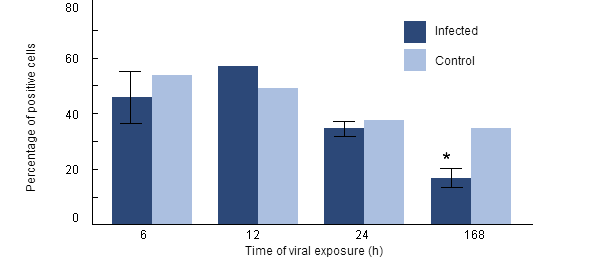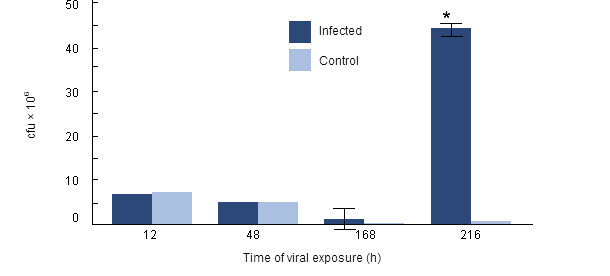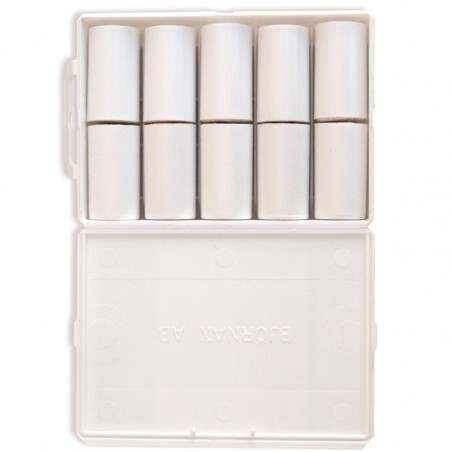Paper
Effect of Porcine Reproductive and Respiratory Syndrome Virus Infection on the Clearance of Haemophilus parasuis by Porcine Alveolar Macrophages Gloria I. Solano, Elida Bautista, Thomas W. Molitor, Joaquim Segales, and Carlos Pijoan. Can J Vet Res 1998; 62: 251-256

Paper summary
What are they studying?
They want to characterize the interaction between PRRSv and Haemophilus parasuis in Porcine Alveolar Macrophages (PAMs).
How is it done?
Nineteen 4-5 week old piglets were selected (PRRSV and ADV negative). Four piglets were euthanized and their PAMs were used for the in-vitro studies: PAMS were inoculated with PRRSv and then exposed to Haemophilus parasuis in order to determine their phagocytosis capacity.
Fifteen piglets were used for the ex-vivo studies; 9 were infected with PRRSv and 6 were kept as controls. The animals were euthanized at different times (6h, 12h, 24h, 168h, and 216h post infection) and their PAMs collected for the rest of the study: PAMs were exposed to Haemophilus parasuis and their phagocytosis and killing capacity determined.
What are the results?
There was a significant reduction in bacterial uptake (phagocytosis) in PAMs collected at 168h (7d) post-infection, which may suggest that phagocytic function may change with time following virus infection.

Figure 1. Phagocytosis rate of H parasuis by porcine alveolar macrophages collected from pigs previously infected with PRRSV.
When intracellular survival was evaluated, there were higher numbers of H. parasuis in PAMs collected from piglets 168h and 216h post-infection as compared to PAMs from non-infected controls, which suggested a marked decrease in the functional ability of PRRSV infected pigs PAMs to kill H.parasuis.

Figure 2. Intracellular survival of H parasuis in porcine alveolar macrophages collected from pigs previously infected with PRRSV.
What implications does this paper have?
It can be suggested that one week (7 and 9 d) after PRRSv infection the decrease in the phagocytic activity of and the superoxide production by PAMs may create a more permissive environment for bacterial colonization by H. parasuis, as in the case studied in this article.
|
Some of us still remember with dread the outbreaks of Glässer's disease that could be seen in the post-weaning phases in those early farms infected with PRRS virus. At that time we all thought that the virus seemed to cause immunosuppression and, therefore, facilitated the entry of other potential pathogens, such as H. parasuis. However, it took almost 10 years to verify that what the PRRS virus actually did was to facilitate the persistence of this bacterium. Up to that time Glässer's disease was also known as stress disease, since it used to appear only in animals that had undergone clearly stressful situations (post-transport, introduction of fattening pigs, etc.) After the arrival of PRRSv to our farms, H. parasuis became one of the most common pathogens in the post-weaning phase, so much so that today nobody is surprised to see the typical symptoms of this infection when recirculation of PRRSv occurs. The results of the article explain how PRRS virus favours infection by H. parasuis. Not because it reduces the number of alveolar macrophages, but because it reduces their ability to inactivate the bacterium, and this effect requires a certain time (at least a week) after the first contact with the virus. In the face of new outbreaks, or recirculations, of PRRS virus on farms, one of the actions we must contemplate taking is post-weaning antibiotic coverage, which will need to be effective for the control of H. parasuis because, given its ubiquity in pig farms, it will very likely be one of the bacteria that will complicate the control of the disease. However, the article allows us to reflect on other aspects of the immune response against bacteria that are often obviated or forgotten. In the study, macrophages were unable to phagocytose bacteria when the latter were not opsonized, and this occurred in all cases. This is important because it implies that in order for piglets to respond to an infection by H. parasuis, they must have circulating antibodies that allow opsonization (coating) of the bacteria, so that they can subsequently be phagocytosed by the alveolar macrophages. It is therefore essential, if these very early infections, that the animals have taken colostrum from their mothers, as it will pass on cellular and humoral immunity that will be vital for their immune response. That is why such techniques as the so-called "McRebel" (leaving suckling piglets in their litters) not only reduces the amount of viraemic piglets at weaning by reducing the chances of infection, but it also improves their response to these bacteria by ensuring proper colostrum intake. |











